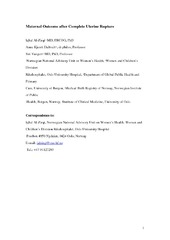Maternal outcome after complete uterine rupture
Peer reviewed, Journal article
Accepted version
Permanent lenke
https://hdl.handle.net/1956/22391Utgivelsesdato
2019Metadata
Vis full innførselSamlinger
Originalversjon
https://doi.org/10.1111/aogs.13579Sammendrag
Introduction: Complete uterine rupture, a rare peripartum complication, is often associated with a catastrophic outcome for both mother and child. However, few studies have investigated large datasets to evaluate maternal outcomes after complete ruptures, particularly in unscarred uteri. This paucity of studies is partly due to the rarity of both the event and the serious outcomes, such as peripartum hysterectomy and maternal death. The incidence of uterine rupture is expected to increase, due to increasing cesarean section rates worldwide. Thus, it is important to have more complete knowledge about the immediate maternal outcome following a complete uterine rupture. The objective was to identify maternal outcomes and their risk factors following complete uterine ruptures. Material and methods: This was a population‐based study using data from the Medical Birth Registry of Norway, the Patient Administration System and medical records. Maternities with complete uterine rupture after start of labor in Norway during 1967‐2008 (n = 247 births), identified among 2 209 506 women. Uterine ruptures were identified from both registries and were further studied through a review of medical records. Only complete ruptures were included in analysis. The associations between maternal outcomes and demographic and labor risk factors were estimated. Odds ratios (OR s) were determined with crude logistic regressions for each risk factor. Separate multivariable logistic regressions were performed to calculate adjusted odds ratios and 95% confidence intervals (CI s). Results: We identified 88 (35.6%) healthy mothers, 107 (43.3%) severe postpartum hemorrhages without hysterectomy, 51 (20.6%) peripartum hysterectomies, and three (1.2%) maternal deaths. Peripartum hysterectomy decreased significantly in the last years of study. Unscarred uterine ruptures significantly increased the risk of peripartum hysterectomy compared with scarred uterine ruptures (AOR 2.6, 95% CI 1.3‐5.3). Other factors that increased the risk of peripartum hysterectomy following rupture were: maternal age ≥35 years (AOR 2.3, 95% CI 1.1‐5.0), parity ≥3 vs parity 1‐2 (AOR 2.8, 95% CI 1.2‐6.7), and rupture detection after vaginal delivery (AOR 2.2, 95% CI 1.1‐4.8). Conclusions: Unscarred uteri, older maternal age, parity ≥3, and rupture detection after vaginal delivery showed the highest associations with the risk of peripartum hysterectomy after complete uterine rupture.
